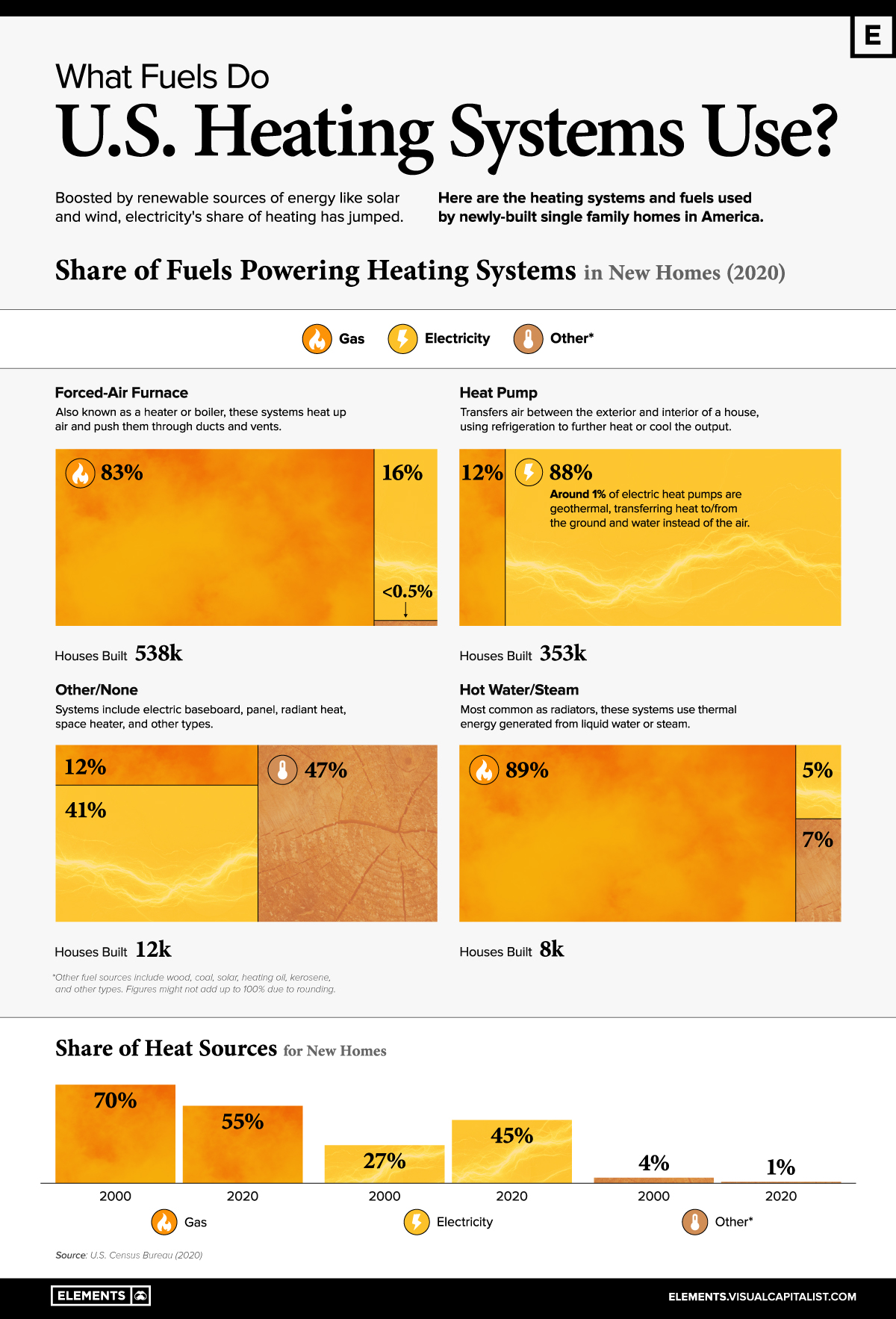Electrification
Charted: Home Heating Systems in the U.S.

Charted: Home Heating Systems in the U.S.
Fossil fuel combustion for the heating of commercial and residential buildings accounts for roughly 13% of annual greenhouse gas emissions in the United States.
Decarbonizing the U.S. economy requires a switch from fossil fuel-combusting heating solutions to renewable energy sources that generate electricity.
Currently, the majority of new homes in the U.S. still combust natural gas for heating through forced-air furnaces or boilers. Just like cars need to be electric, homes will need to switch to electricity-powered heating systems that use renewable energy sources.
The graphic above uses census data to break down the different heating systems and fuels that are warming the 911,000 single-family homes built in the U.S. in 2020.
Types of Home Heating Systems
Most American homes use one of the following three heating systems:
- Forced-air Furnaces: These typically have a burner in a furnace that is fueled by natural gas. A blower forces cold air through a heat exchanger which warms it up before it flows through ducts that heat the home with air as the medium.
- Heat Pumps: The most common type of heat pumps are air-source heat pumps, which collect hot air from outside the home and concentrate it before pumping it through ducts that heat the air inside. They are usually powered by electricity. During warmer months, heat pumps can reverse themselves to cool the home, transferring hot air from the inside to the outdoors.
- Hot Water/Steam: These systems typically work by boiling water (or generating steam) to the appropriate temperature using gas and sending it through a home’s pipes to radiators that heat the air.
How Home Heating Fuels Have Changed
U.S. home heating has been going through a transition over the last two decades. Electricity has steadily been replacing gas and biofuel/wood-powered home heating systems for new homes, and powers almost half of the heating systems in single-family homes built in 2020.
Here’s how the share of heat sources for new houses changed between 2000 and 2020:
| Fuel | 2000 % of Heating for New Homes | 2020 % of Heating for New Homes |
|---|---|---|
| Gas | 70% | 55% |
| Electricity | 27% | 45% |
| Other | 4% | 1% |
Percentages may not add to 100 due to rounding.
While electricity’s share has grown since 2000, most American homes are still heated with gas largely because of the fossil fuel’s affordability.
According to the U.S. Energy Information Administration (EIA), households relying on gas for space heating are expected to spend an average of $746 over the winter months, compared to $1,268 for electricity, and $1,734 for heating oil.
Heating in Newly-Built Houses Today
Of the 911,000 new single-family homes, 538,000 houses installed forced-air furnaces. Of these, 83% or nearly 450,000 homes used gas as the primary heating source, with 16% opting for electrified furnaces. By contrast, 88% of the 353,000 homes that installed heat pumps relied on electricity.
Here’s how the heating systems and fuels break down for single-family homes built in 2020:
| System Used | Houses Built in 2020 | % Powered by Gas | % Powered by Electricity | % Powered by Other |
|---|---|---|---|---|
| Forced-Air Furnace | 538,000 | 83% | 16% | <0.5% |
| Heat Pump | 353,000 | 12% | 88% | 0% |
| Hot Water/Steam | 8,000 | 89% | 5% | 7% |
| Other/None | 12,000 | 12% | 41% | 47% |
Percentages may not add to 100 due to rounding.
Fewer than 1% of new single-family homes used hot water or steam systems, and the majority of those that did relied on gas as the primary fuel. Around 1.3% of new homes used other systems like electric baseboard heaters, smaller space heaters, panel heaters, or radiators.
While gas remains the dominant heating source today, efforts to decarbonize the U.S. economy could further prompt a shift towards electricity-based heating systems, with electric heat pumps likely taking up a larger piece of the pie.
Electrification
Charted: 4 Reasons Why Lithium Could Be the Next Gold Rush
Visual Capitalist has partnered with EnergyX to show why drops in prices and growing demand may make now the right time to invest in lithium.

4 Reasons Why You Should Invest in Lithium
Lithium’s importance in powering EVs makes it a linchpin of the clean energy transition and one of the world’s most precious minerals.
In this graphic, Visual Capitalist partnered with EnergyX to explore why now may be the time to invest in lithium.
1. Lithium Prices Have Dropped
One of the most critical aspects of evaluating an investment is ensuring that the asset’s value is higher than its price would indicate. Lithium is integral to powering EVs, and, prices have fallen fast over the last year:
| Date | LiOH·H₂O* | Li₂CO₃** |
|---|---|---|
| Feb 2023 | $76 | $71 |
| March 2023 | $71 | $61 |
| Apr 2023 | $43 | $33 |
| May 2023 | $43 | $33 |
| June 2023 | $47 | $45 |
| July 2023 | $44 | $40 |
| Aug 2023 | $35 | $35 |
| Sept 2023 | $28 | $27 |
| Oct 2023 | $24 | $23 |
| Nov 2023 | $21 | $21 |
| Dec 2023 | $17 | $16 |
| Jan 2024 | $14 | $15 |
| Feb 2024 | $13 | $14 |
Note: Monthly spot prices were taken as close to the 14th of each month as possible.
*Lithium hydroxide monohydrate (MB-LI-0033)
**Lithium carbonate (MB-LI-0029)
2. Lithium-Ion Battery Prices Are Also Falling
The drop in lithium prices is just one reason to invest in the metal. Increasing economies of scale, coupled with low commodity prices, have caused the cost of lithium-ion batteries to drop significantly as well.
In fact, BNEF reports that between 2013 and 2023, the price of a Li-ion battery dropped by 82%.
| Year | Price per KWh |
|---|---|
| 2023 | $139 |
| 2022 | $161 |
| 2021 | $150 |
| 2020 | $160 |
| 2019 | $183 |
| 2018 | $211 |
| 2017 | $258 |
| 2016 | $345 |
| 2015 | $448 |
| 2014 | $692 |
| 2013 | $780 |
3. EV Adoption is Sustainable
One of the best reasons to invest in lithium is that EVs, one of the main drivers behind the demand for lithium, have reached a price point similar to that of traditional vehicle.
According to the Kelly Blue Book, Tesla’s average transaction price dropped by 25% between 2022 and 2023, bringing it in line with many other major manufacturers and showing that EVs are a realistic transport option from a consumer price perspective.
| Manufacturer | September 2022 | September 2023 |
|---|---|---|
| BMW | $69,000 | $72,000 |
| Ford | $54,000 | $56,000 |
| Volkswagon | $54,000 | $56,000 |
| General Motors | $52,000 | $53,000 |
| Tesla | $68,000 | $51,000 |
4. Electricity Demand in Transport is Growing
As EVs become an accessible transport option, there’s an investment opportunity in lithium. But possibly the best reason to invest in lithium is that the IEA reports global demand for the electricity in transport could grow dramatically by 2030:
| Transport Type | 2022 | 2025 | 2030 |
|---|---|---|---|
| Buses 🚌 | 23,000 GWh | 50,000 GWh | 130,000 GWh |
| Cars 🚙 | 65,000 GWh | 200,000 GWh | 570,000 GWh |
| Trucks 🛻 | 4,000 GWh | 15,000 GWh | 94,000 GWh |
| Vans 🚐 | 6,000 GWh | 16,000 GWh | 72,000 GWh |
The Lithium Investment Opportunity
Lithium presents a potentially classic investment opportunity. Lithium and battery prices have dropped significantly, and recently, EVs have reached a price point similar to other vehicles. By 2030, the demand for clean energy, especially in transport, will grow dramatically.
With prices dropping and demand skyrocketing, now is the time to invest in lithium.
EnergyX is poised to exploit lithium demand with cutting-edge lithium extraction technology capable of extracting 300% more lithium than current processes.

Electrification
Ranked: The Top 10 EV Battery Manufacturers in 2023
Asia dominates this ranking of the world’s largest EV battery manufacturers in 2023.

The Top 10 EV Battery Manufacturers in 2023
This was originally posted on our Voronoi app. Download the app for free on iOS or Android and discover incredible data-driven charts from a variety of trusted sources.
Despite efforts from the U.S. and EU to secure local domestic supply, all major EV battery manufacturers remain based in Asia.
In this graphic we rank the top 10 EV battery manufacturers by total battery deployment (measured in megawatt-hours) in 2023. The data is from EV Volumes.
Chinese Dominance
Contemporary Amperex Technology Co. Limited (CATL) has swiftly risen in less than a decade to claim the title of the largest global battery group.
The Chinese company now has a 34% share of the market and supplies batteries to a range of made-in-China vehicles, including the Tesla Model Y, SAIC’s MG4/Mulan, and Li Auto models.
| Company | Country | 2023 Production (megawatt-hour) | Share of Total Production |
|---|---|---|---|
| CATL | 🇨🇳China | 242,700 | 34% |
| BYD | 🇨🇳China | 115,917 | 16% |
| LG Energy Solution | 🇰🇷Korea | 108,487 | 15% |
| Panasonic | 🇯🇵Japan | 56,560 | 8% |
| SK On | 🇰🇷Korea | 40,711 | 6% |
| Samsung SDI | 🇰🇷Korea | 35,703 | 5% |
| CALB | 🇨🇳China | 23,493 | 3% |
| Farasis Energy | 🇨🇳China | 16,527 | 2% |
| Envision AESC | 🇨🇳China | 8,342 | 1% |
| Sunwoda | 🇨🇳China | 6,979 | 1% |
| Other | - | 56,040 | 8% |
In 2023, BYD surpassed LG Energy Solution to claim second place. This was driven by demand from its own models and growth in third-party deals, including providing batteries for the made-in-Germany Tesla Model Y, Toyota bZ3, Changan UNI-V, Venucia V-Online, as well as several Haval and FAW models.
The top three battery makers (CATL, BYD, LG) collectively account for two-thirds (66%) of total battery deployment.
Once a leader in the EV battery business, Panasonic now holds the fourth position with an 8% market share, down from 9% last year. With its main client, Tesla, now effectively sourcing batteries from multiple suppliers, the Japanese battery maker seems to be losing its competitive edge in the industry.
Overall, the global EV battery market size is projected to grow from $49 billion in 2022 to $98 billion by 2029, according to Fortune Business Insights.
-

 Electrification3 years ago
Electrification3 years agoRanked: The Top 10 EV Battery Manufacturers
-

 Electrification2 years ago
Electrification2 years agoThe Key Minerals in an EV Battery
-

 Real Assets3 years ago
Real Assets3 years agoThe World’s Top 10 Gold Mining Companies
-

 Misc3 years ago
Misc3 years agoAll the Metals We Mined in One Visualization
-

 Energy Shift2 years ago
Energy Shift2 years agoWhat Are the Five Major Types of Renewable Energy?
-

 Electrification2 years ago
Electrification2 years agoMapped: Solar Power by Country in 2021
-

 Electrification2 years ago
Electrification2 years agoThe World’s Largest Nickel Mining Companies
-

 Misc3 years ago
Misc3 years agoThe Largest Copper Mines in the World by Capacity



















